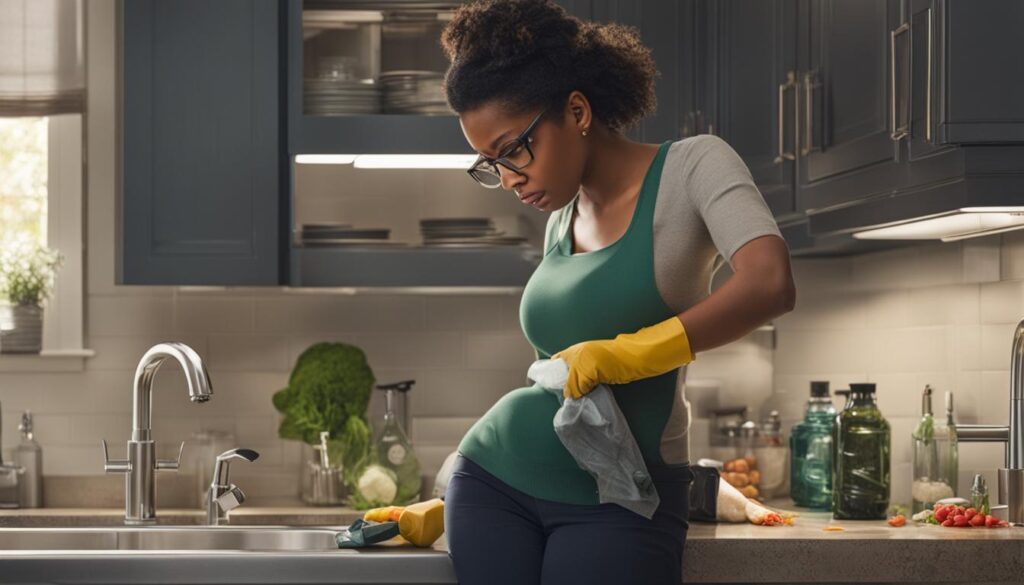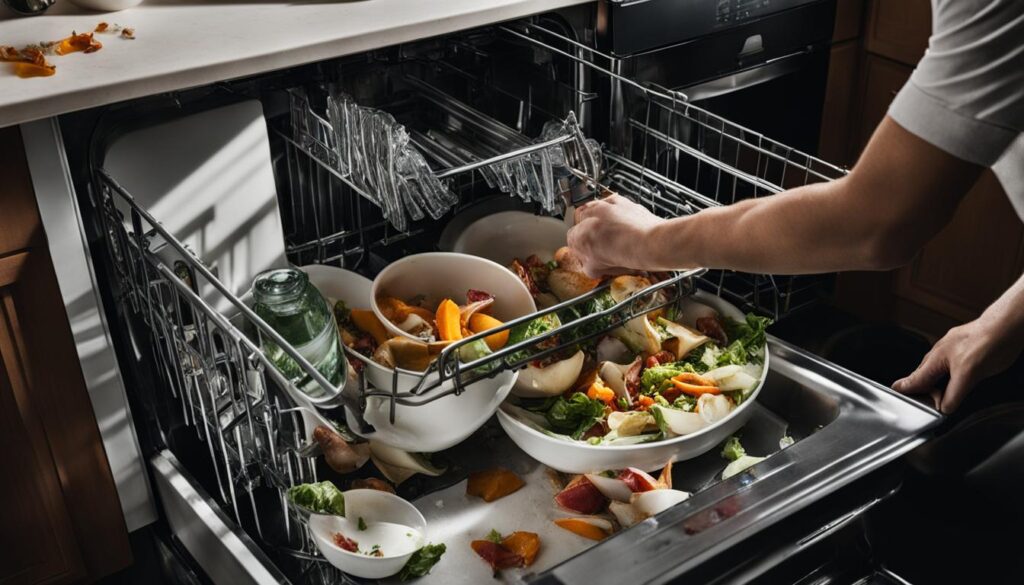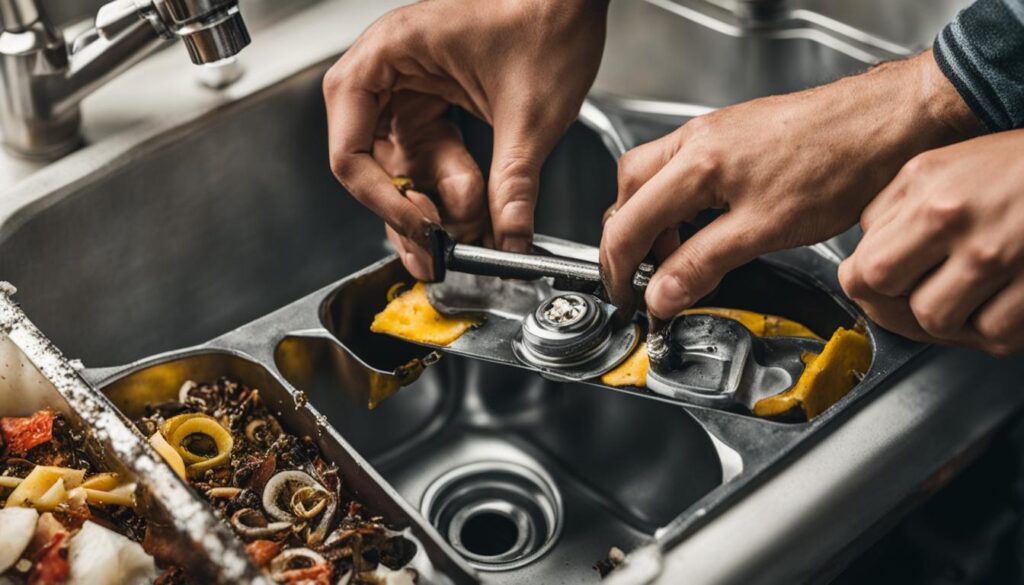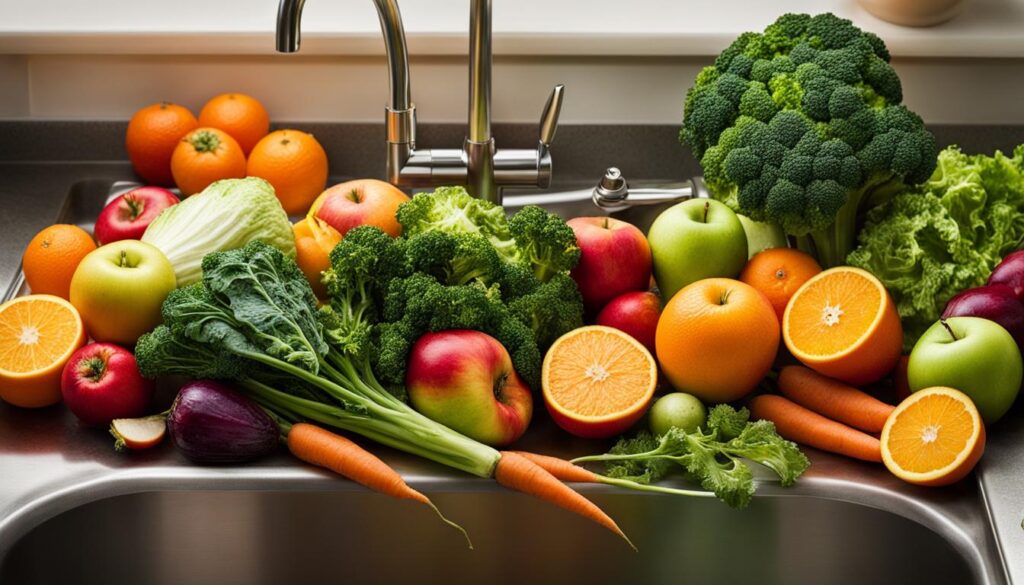If your garbage disposal is broken, you may be wondering if it is still safe to use your sink. The most common reasons for a broken garbage disposal include jamming, overloading, or electrical issues. Jamming occurs when foreign objects or tough food scraps obstruct the disposal’s blades. Overloading the disposal with excessive waste can trip its safety mechanisms. Electrical issues like a tripped circuit breaker or a faulty switch can also prevent the disposal from functioning properly. However, using the sink without a functional garbage disposal is still possible, as long as you take precautions to prevent clogs and ensure proper drainage.
Key Takeaways:
- When the garbage disposal is broken, you can still use the sink by taking precautions to prevent clogs and ensure proper drainage.
- The most common reasons for a broken garbage disposal are jamming, overloading, and electrical issues.
- Jammed items can obstruct the disposal’s blades, while overloading it can trip safety mechanisms.
- If the disposal is not working due to electrical issues, check the circuit breaker and power source.
- Using the dishwasher is still possible even with a broken garbage disposal, but the connection between them should be considered.
Troubleshooting Common Garbage Disposal Problems
If your garbage disposal is not working, it can be frustrating and inconvenient. However, before calling a plumber, there are a few common issues you can troubleshoot on your own. By following these steps, you may be able to resolve the problem and avoid unnecessary expenses.
First, start by checking the basics. Make sure that the garbage disposal is plugged in and that the power switch is turned on. Sometimes, a simple oversight can lead to the disposal not working. If the unit has a built-in circuit breaker, look for a reset button and press it. This can often solve minor electrical issues that may have caused the disposal to stop working.
If the disposal still does not work after checking the power and resetting the circuit breaker, there may be a jam in the flywheel. To address this, you can use a wrench or a long stick to manually rotate the flywheel and dislodge any obstructions. Be sure to turn off the power to the disposal before attempting this method.
If these troubleshooting steps do not resolve the issue, it is recommended to call a plumber for further assistance. They will have the expertise to diagnose and repair the problem effectively and safely.

Troubleshooting Common Garbage Disposal Problems
| Problem | Possible Solution |
|---|---|
| The disposal is not turning on. | Check power source, reset circuit breaker, or call a plumber for further assistance. |
| The disposal is making a humming noise but not grinding. | Use a wrench or a long stick to manually rotate the flywheel and dislodge any obstructions. |
| The disposal is leaking. | Tighten or replace the mounting flange, repair seals, or call a plumber for further assistance. |
Remember, proper maintenance and regular use of your garbage disposal can help prevent many common issues. Follow best practices such as running cold water when using the disposal, avoiding overloading it, and not disposing of non-food items. By taking these precautions and addressing problems promptly, you can keep your garbage disposal working well for years to come.
Using the Dishwasher with a Broken Garbage Disposal
If your garbage disposal is broken, you may be wondering if it will affect the functionality of your dishwasher. The good news is that in most cases, you can still use your dishwasher even if the garbage disposal is not working properly. While the dishwasher and garbage disposal may be connected in some instances, the dishwasher can still function independently.
If your dishwasher is connected to the garbage disposal, it may drain through the disposal. In this case, a clogged or malfunctioning garbage disposal can potentially cause the dishwasher to back up. However, if your dishwasher is not connected to the garbage disposal at all, you can continue using it without any concerns.
To determine the connection between your dishwasher and garbage disposal, you can refer to the user manual or consult a professional if you’re unsure. Understanding the specific setup in your home will help you make an informed decision about using the dishwasher with a broken garbage disposal.

Why You Can Still Use Your Dishwasher
Even if your dishwasher does drain through the garbage disposal, it’s important to note that the two appliances have separate functions. The dishwasher is designed to clean and sanitize your dishes, while the garbage disposal is meant to break down food waste.
While a functioning garbage disposal can help with the disposal of food scraps from your dishes, it is not a necessary component for the dishwasher’s primary function. As long as your dishwasher is properly connected to the plumbing system, it should continue to work efficiently without the need for a functioning garbage disposal.
Precautions to Take
Although you can use your dishwasher without a working garbage disposal, it’s still important to take certain precautions to prevent clogs and ensure proper drainage. Be mindful of the types of food scraps that go into the dishwasher to minimize the risk of debris accumulating in the drain and causing a backup.
Before running your dishwasher, scrape off excess food remnants from dishes and utensils into the trash can. Avoid disposing of large chunks of food or items that could potentially clog the drain. Additionally, periodically check and clean the dishwasher filter to remove any buildup that could impede drainage.
By following these precautions and understanding the connection between your dishwasher and garbage disposal, you can continue to use your dishwasher even if your garbage disposal is broken.
Troubleshooting and Repairing a Broken Garbage Disposal
If you’re experiencing issues with your garbage disposal, there are several steps you can take to troubleshoot and repair it before considering replacements or calling a professional. Start by checking the power source to ensure that the disposal is properly plugged in and that the circuit breaker hasn’t tripped. If there is power, but the disposal is still not working, you may need to manually rotate the impeller plate or blades to dislodge any obstructions that are causing the problem. This can be done using a wrench or a long stick.
Another common issue with garbage disposals is leaking. If you notice any leaks, it’s important to address them promptly. You can tighten or replace the mounting flange, which is the component that connects the disposal to the sink, or repair any damaged seals. If you’re unsure of how to perform these repairs, it’s best to consult a professional plumber for assistance.
However, if your troubleshooting efforts don’t resolve the issue, it may be time to consider replacing the garbage disposal. Over time, these appliances can wear out and become less efficient at grinding food waste. It’s recommended to consult with a professional to determine the best replacement option for your specific needs.
| Common Garbage Disposal Issues | Troubleshooting Steps |
|---|---|
| The disposal is not working and there is power | Manually rotate the impeller plate or blades to dislodge obstructions |
| There are leaks in the disposal | Tighten or replace the mounting flange or repair damaged seals |
| Garbage disposal is old or not functioning efficiently | Consider replacing the unit |
Remember, if you’re unsure about any repairs or troubleshooting steps, it’s always best to consult with a professional plumber. They have the knowledge and experience to handle any issues with your garbage disposal effectively and safely.
Best Practices for Using and Maintaining a Garbage Disposal
To ensure the proper functioning and longevity of your garbage disposal, it’s important to follow some best practices for usage and maintenance. By incorporating these tips into your routine, you can prevent common issues and keep your disposal in excellent condition.
Proper Operation
When using your garbage disposal, remember to run cold water before, during, and after grinding food scraps. Cold water helps solidify grease and fats, preventing them from clogging the drain. It’s also essential to feed the disposal small amounts of food waste at a time to avoid overloading the unit. Grinding a cup of ice occasionally helps sharpen the blades and remove any buildup. Additionally, consider running dish soap through the disposal to keep it clean and fresh.
Maintenance Schedule
Regular maintenance is key to preventing garbage disposal issues. Make it a habit to run the disposal regularly, even if there is no food waste, to prevent rust and corrosion. It’s also recommended to check for leaks and tighten or replace the mounting flange or seals if necessary. For optimal performance, avoid using chemical drain cleaners as they can cause damage to the disposal. Instead, opt for natural remedies like a mixture of vinegar and baking soda to keep the unit clean and free from odors.
Prohibited Items
To avoid damaging your garbage disposal, it’s important to be mindful of what you put into it. While most biodegradable food scraps are safe, there are some items you should never dispose of in the unit. Avoid putting large bones, fruit seeds, fibrous plant scraps, rice, pasta, shrimp and seafood shells, and coffee grounds into the disposal. These items can cause clogs, damage the blades, or create unpleasant odors. Remember to cut food waste into small pieces before placing it into the disposal to ensure smooth operation.
| Proper Operation | Maintenance Schedule | Prohibited Items |
|---|---|---|
| Run cold water when using the disposal | Run the disposal regularly to prevent rust and corrosion | Avoid putting large bones into the disposal |
| Feed the disposal small amounts of food waste at a time | Check for leaks and tighten or replace mounting flange or seals | Avoid disposing of fruit seeds and fibrous plant scraps |
| Occasionally grind a cup of ice to sharpen the blades | Avoid using chemical drain cleaners | Do not put rice, pasta, shrimp and seafood shells into the disposal |
| Run dish soap through the disposal to keep it clean | Use natural remedies like vinegar and baking soda for cleaning | Avoid disposing of coffee grounds |
By following these best practices, you can maintain a well-functioning garbage disposal and avoid common issues. Regular operation, proper maintenance, and careful disposal of food waste will ensure the longevity of your unit, saving you from costly repairs or replacements in the future.

What to Put Into and Keep Out of a Garbage Disposal
A garbage disposal is a helpful appliance in the kitchen that can handle most biodegradable food scraps. Knowing what you can safely put into the disposal and what to avoid is essential to prevent clogs, damage to the blades, and unpleasant odors. Here’s a guide on what can go into a garbage disposal and the items you should keep out:
Foods that can go into a garbage disposal:
- Vegetable and fruit scraps
- Fish bones
- Small meat scraps
These items are safe to dispose of in the garbage disposal as they are biodegradable and won’t cause any major issues. However, it’s always a good idea to cut larger food waste into smaller pieces to facilitate the disposal process.
Items to avoid disposing in a garbage disposal:
- Cooking fats, grease, and oils
- Large bones
- Fruit seeds
- Fibrous plant scraps (such as celery)
- Raw vegetables
- Rice and pasta
- Shrimp and seafood shells
- Large meat portions
- Coffee grounds
These items can cause clogs, damage the blades, and create foul odors in your garbage disposal. It’s best to dispose of them in alternative ways, such as composting or throwing them in the trash.
By following these guidelines, you can ensure that your garbage disposal remains in good working condition and avoid unnecessary plumbing issues. Remember to always use cold water when running the disposal to prevent grease from solidifying, and never overload it with excessive waste.

Conclusion
In summary, if you have a broken garbage disposal, you can still use your sink with some precautions. Take the time to troubleshoot common issues like checking power sources and dislodging any jams. Understanding the connection between your dishwasher and garbage disposal will help you determine if the dishwasher can still function without a working disposal.
Remember to follow best practices for using and maintaining your garbage disposal to prevent clogs and ensure its proper functioning. Regularly run the unit, use cold water, and avoid overloading it. Be mindful of what goes into the disposal to avoid damaging the blades or causing unpleasant odors.
If troubleshooting doesn’t resolve the issue or if you encounter leaks, it’s best to call a professional for repairs or replacement. They have the expertise to handle more complex problems and ensure your garbage disposal is functioning optimally.
FAQ
Can I use the sink if the garbage disposal is broken?
Yes, you can still use your sink without a functional garbage disposal. Just take precautions to prevent clogs and ensure proper drainage.
How can I troubleshoot common garbage disposal problems?
First, check that the disposal is plugged in and the power switch is on. If it’s still not working, try resetting the unit’s built-in circuit breaker and checking the circuit breaker at your home’s electrical panel. If these steps don’t work, try dislodging any jams in the disposal’s flywheel using a wrench or a long stick. If all else fails, call a plumber for assistance.
Can I still use my dishwasher if the garbage disposal is broken?
In most cases, you can still use your dishwasher even if the garbage disposal is broken. The dishwasher is not directly connected to the garbage disposal, although it may drain through the disposal in some cases. If the disposal is clogged, it may cause the dishwasher to back up. However, if the dishwasher is not connected to the garbage disposal at all, you can still use it without any problems.
How can I troubleshoot and repair a broken garbage disposal?
First, check the power source and ensure the unit is plugged in and the circuit breaker is not tripped. If there is power, but the disposal is not working, try manually rotating the impeller plate or blades to dislodge any obstructions. If the disposal is leaking, tighten or replace the mounting flange or repair a seal. If these troubleshooting steps don’t work, it’s best to call a professional for repairs or replacement.
What are the best practices for using and maintaining a garbage disposal?
To prevent issues and ensure proper functioning, run the disposal regularly, use cold water to prevent grease from solidifying, periodically run dish soap through it, avoid overloading, grind small amounts of food waste at a time, and sharpen the blades by grinding a cup of ice occasionally.
What can I put into and keep out of a garbage disposal?
You can put vegetable and fruit scraps, fish bones, and small meat scraps into the disposal. However, avoid putting cooking fats, grease, oils, large bones, fruit seeds, fibrous plant scraps, raw vegetables, rice, pasta, shrimp and seafood shells, large meat portions, and coffee grounds into the disposal. These items can cause clogs, damage the blades, or create unpleasant odors.
Can you provide a summary or conclusion?
In summary, you can still use your sink even if the garbage disposal is broken. Take the necessary precautions to prevent clogs and ensure proper drainage. Troubleshoot common issues before calling a plumber. Understand the dishwasher’s connection to the garbage disposal to determine if it will still function without a working disposal. If all else fails, call a professional for repairs or replacement.